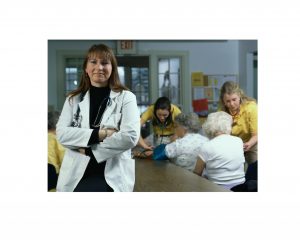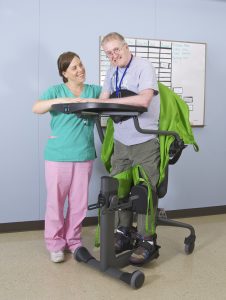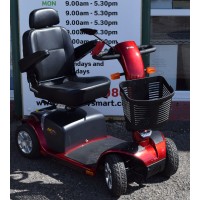Dr. Mauk’s Boomer Blog
Each week, Dr. Kristen Mauk shares thoughts relevant to Baby Boomers that are aimed to educate and amuse.
Dr. Kristen L. Mauk, PhD, DNP, RN, CRRN, GCNS-BC, GNP-BC, FAAN

Guest Blog:Technology in mobility, a smarter outlook!
In a world where technology seems to pervade every aspect of our lives, we take a look at how technology can make a positive contribution to care and making the lives of your loved ones easier and more dignified in later life.
Many people will be familiar with the term ‘Aids To Daily Living’. This simply describes a category of products that do exactly what the term implies. Usually associated with smaller products that help in the home or the garden, these products are at the forefront in the push for technological breakthroughs as manufacturers look for the next big seller!
This relentless drive has meant that the Living Aids sector has grown massively from just a few lines of products in the early eighties, to quite literally thousands of product lines and growing today.
Examples of some Daily Living Aids include easy grip cutlery; can and bottle openers, long handled tools, the list is almost endless and there are new innovations being developed daily.
Technology has pushed the advancement of lightweight materials including new plastics, metals alloys and electronic components that have revolutionised many products. A good example of this is the walking stick, formerly made of cane in a one-size-fits-all configuration; the walking stick now has many types, materials, colours and setting options. Many of the enhancements have been borrowed from the world of high end sport, F1, military and even space!
Further evidence of this technological boundary breaking has been in the field of medical prosthetics where both mechanical engineering and state of the art electronics mean that disabled people are now receiving much greater movement options as bio and electronic systems become ever more intertwined.
The care sector has always been hungry for new technology, as most readers will be aware it is the smaller sometimes mundane tasks that affect our loved ones and that require specialist products that can help. The search for these products can be challenging but the internet can be a valuable resource to locate Daily Living Aids that can be most useful.
It is usually a good idea to start with the problem when looking for new products, i.e. ‘problems reaching high shelves’ – searches like this will often bring up some product based results and technology based answers. Another good resource is forums where new technology is discussed and you can canvas the experience of other product users.
A greater range of Daily Living Aids products can mean more independence as more tasks become available through the tools available. It can make a big difference to self-esteem as the person can continue to feel they can perform ordinary tasks, albeit with a little help in the right direction, and sometimes a little push to get them to adopt something new!
As with all technology, it will continue and this will mean that in the future we can look through to even more discoveries that can contribute to increased mobility and independent living of our loved ones; this can only be a good thing and is a great example of using technology in a positive way, for the benefit of all.
This post was written on behalf of Andrew Atkinson. Andrew is a director of mobility products specialists MobilitySmart and has written many articles on providing health and mobility tips .
Guest Post: Why Mobility Aids Don’t Need to Be Used Long Term
There’s a common misconception that the moment you buy a mobility aid, such as a walking frame or mobility scooter, is the moment you give up your independence.
It’s easy to see why someone could feel like they’re giving in to old age, with stereotypes showing seniors that can’t do anything for themselves.
Take a look at things a different way. Instead of feeling like you’re giving up and accepting defeat, look at your mobility aid as a sensible choice for increasing independence and freedom.
Do they need to be a permanent fixture once you’ve bought them?
Nobody’s going to connect you to a mobility scooter, or fuse you to a walking frame. They don’t become a part of you, just because you’ve bought them. You’re free to use them as little or as often as you’d like. You might just use your mobility aid for long-distance walks or days out with the grandkids. Alternatively, you might decide that you need to use them every time you go to the store.
Aren’t some mobility aids too expensive for occasional use?
Mobility scooters certainly aren’t the cheapest things, but they’re a whole lot cheaper than a car! And they’ll probably do more for your overall independence, too.
There are ways to keep your costs down. If you’re confident that you need a mobility aid only in really rare circumstances, you might find that it’s cheaper to hire a mobility scooter than to buy one to keep at home. Some attractions, such as theme parks, offer mobility scooter hire. Otherwise, look for a company that specifically offers this service.
If you think that you’re going to need your mobility aid more frequently, but if you’re really not ready to commit to a high value purchase, you might find that buying used is the best option for you and your bank balance.
Pre owned mobility scooters cost a lot less than brand new ones, and if you buy from a reputable company then they should be professionally refurbished, serviced and checked.
Alternatively, if you’re planning to use your mobility scooter almost daily, it’s probably worth buying brand new. That way, you’ll get the longest possible lifespan combined with the newest features, and premium manufacturer support.
Is a mobility scooter always the best choice?
If you’re really struggling to get around then a mobility scooter could be the best purchase for you. They can be used to travel over relatively long distances, comfortably and easily, and are for indoor and outdoor use.
If you simply need a little support to walk on your own two feet, crutches, a walking stick or a walking frame might be a better choice.
Wheelchairs, including electric wheelchairs, have always been a popular option. It’s worth noting, however, that these don’t have the same sturdy build as a mobility scooter and won’t be so good on bumpy surfaces or long-term outdoor use.
Whatever you choose, feel free to use your mobility aid one day and set it aside the next. There are no rules as long as you’re happy with your investment.
Mobility Smart is an online retailer stocking a wide range of mobility aids and daily living aids, including new and used mobility scooters and other walking aids for people with limited mobility. Click here to find out more.
How to Maintain Mental Wellness in Your Senior Years
Introduction
Aging is a characteristic piece of life, and as we become older, maintaining excellent mental health turns out to be increasingly crucial. While actual health frequently takes the spotlight, mental wellness is similarly fundamental in ensuring a top-notch life during one’s senior years. In this article, we will investigate the critical techniques to maintain mental wellness in your old years, taking inspiration from mental health influencers who have prepared for positive aging.
The Meaning of Mental Wellness in Seniors
Mental wellness incorporates close-to-home, mental, and social prosperity. It involves managing pressure, maintaining connections, and making decisions that upgrade your satisfaction. In your senior years, mental wellness is especially critical because of multiple factors:
- Emotional Resilience
The capacity to deal with life’s difficulties and return quickly from misfortune is essential for seniors. Excellent mental health empowers profound flexibility, helping seniors adapt to health issues, misfortune, and other life-altering events.
- Cognitive Function
Mental wellness is intently attached to mental capability. Staying mentally dynamic through exercises like reading, riddles, and learning new abilities can assist seniors with preserving their mental capacities and memory.
- Quality of Life
Seniors with significant mental health are bound to partake in a top-notch life. They can remain socially connected, seek after their interests, and continue to lead fulfilling lives.
- Physical Health
Mental and actual health intertwine. Seniors with solid mental wellness are bound to participate in healthy behavior, like activity, a reasonable eating routine, and normal healthcare visits.
Methodologies for Maintaining Mental Wellness
- Stay Truly Active
Normal activity is a valuable asset for maintaining mental wellness. It discharges endorphins, which can support the mind-set and lessen the gamble of sorrow. Exercises like walking, swimming, or yoga can assist with keeping both body and mind in top shape. Mental health influencers frequently stress the association between actual work and profound prosperity.
- Maintain Social Connections
Loneliness and social segregation can harm mental health. Seniors ought to effectively search out friendly interactions with family, companions, and, surprisingly, new acquaintances. Mental health influencers frequently energize the significance of maintaining solid informal organizations.
- Pursue lasting Learning
Engaging in continuous learning is a successful method for keeping the mind sharp and advancing mental wellness. Whether it’s picking up another side interest, learning an instrument, or taking courses, intellectual pursuits can give a feeling of achievement and motivation.
- Manage Stress
Stress is a piece of life, yet persistent pressure can negatively affect mental health. Practicing pressure-the-board strategies like reflection, profound breathing, and mindfulness can assist seniors with staying quiet and centered. Mental health influencers frequently share their encounters with pressure-decrease plans.
- Seek Proficient Support
Assuming seniors are experiencing symptoms of despair, uneasiness, or other mental health issues, looking for proficient help is fundamental. Mental health influencers frequently destigmatize treatment and counseling, emphasizing that seeking support is a bold move toward better mental health.
- Stay Positive
Maintaining an uplifting perspective on life can fundamentally influence mental wellness. Practicing appreciation, focusing on the present, and embracing a feeling of direction can assist seniors with finding euphoria and satisfaction in their senior years. Mental health influencers frequently share inspirational and positive messages to inspire their supporters.
Manage Constant Illness
Seniors frequently must adapt to persistent health conditions. Managing these circumstances successfully is pivotal for mental wellness. Adhering to treatment plans, staying informed, and seeking support gatherings can all add to better close-to-home prosperity.
Engage in Imaginative Expression
Innovative articulation, like artistry, writing, or music, can be a helpful source for seniors. It permits them to articulate their thoughts, process their feelings, and find satisfaction in their imaginative undertakings. Mental health influencers frequently utilize innovative articulation as a method for sharing their stories and inspiring others.
Volunteer and Give Back
Volunteering isn’t just a method for giving back to the local area but also a valuable chance to feel a feeling of direction and achievement. Helping others can support confidence and mental prosperity. Numerous mental health influencers find satisfaction in their backing work and volunteering endeavors.
- Embrace Technology
Innovation can assist seniors with staying associated with friends and family, accessing mental health assets, and participating in mentally stimulating exercises. Utilizing cell phones, tablets, and PCs can open up a universe of chances for seniors to remain mentally dynamic and socially locked in.
Inspirational Mental Health Influencers
Mental health influencers have made considerable commitments to the talk on profound prosperity in seniors and individuals, everything being equal. Their stories and support endeavors act as an inspiration for seniors looking to maintain their mental wellness. The following are a couple of influential figures who have made ready:
- Patricia Edgar
Patricia Edgar, a promoter for senior mental wellness, has spoken enthusiastically about the significance of staying dynamic and socially associated and participating in meaningful exercises in one’s senior years. Her backing has inspired numerous seniors to lead dynamic and fulfilling lives.
- John Grohol
As the organizer behind Psych Focal, John Grohol has been a vocal defender of mental health mindfulness. His work underlines the significance of seeking proficient help and reducing the shame surrounding mental health issues.
- Wendy Sue Swanson
Dr. Wendy Sue Swanson, a pediatrician, has utilized her foundation to urge a comprehensive way to deal with mental wellness, highlighting the association between physical and psychological health. She advocates for standard activity, nourishment, and a solid interpersonal organization.
- Rudy Caseres
Rudy Caseres has become a prominent promoter of mental health mindfulness, especially within the senior local area. His endeavors have urged seniors to look for treatment, decrease the shame surrounding mental health, and participate in open discussions about their close-to-home prosperity.
Conclusion
Maintaining mental wellness in your senior years isn’t just imaginable but fundamental for a fulfilling and meaningful life. The systems examined, inspired by mental health influencers, offer a guide for promoting close-to-home prosperity in seniors. Staying genuinely dynamic, nurturing social associations, embracing deep-rooted learning, and managing pressure are almighty tools to improve mental health and make a positive aging encounter. The excursion to mental wellness in your senior years is an ongoing cycle; one loaded up with open doors for development, association, and a significant feeling of satisfaction.
Sometimes We Just Need a Little Grace
This is my dog. Her name is Grace. We fondly call her Gracie.
Gracie is a miniature pinscher, born just over 9 years ago, the last of a six-puppy litter. She was barely 3 inches long at birth and a third the size of the other puppies. We doubted she would survive. Her mother rejected her and tried to throw her out of “the nest” because she was different than the other puppies.
But my children and I believed in Gracie’s survival. We fed her by hand with an eyedropper as we cradled her in our palms, and we gave her the love and nurture she didn’t get from her own family of dogs. I had to lay her mother on my lap so that Gracie could be nursed apart from the others. When she was too weak to nurse, the kids and I took shifts to feed her around the clock and speak encouraging words of survival to her. Soon she became the strongest and most dominant of the pack, although still the smallest. She could fend off her five littermates from the food bowl with a fierce growl and scary glance. And Gracie repaid our faith in her will to live by returning the care and comfort she received from us with a lifetime of love and companionship.
Now that she is an older adult dog, she shows those signs of aging that we all do: gray hair, hearing loss, cataracts, stiff joints, and some excess weight around the middle. But like so many of us Baby Boomer humans, Gracie has the heart and soul of her younger years. She will still chase a chipmunk, but no longer catches it. She can still jump around with excitement, but then promptly falls asleep on the couch. Even in her old age, she continues to teach us about another kind of grace.
When I return from a business trip, Gracie is the first to greet me. Long before my husband or kids make it to the door, she hears my footsteps and comes running. You would think I was the most important person on earth as she jumps and whines and licks me, climbing in my lap for some affection. She makes me feel like a queen. It doesn’t matter to Gracie if I am in a grumpy mood, if I’m overweight, or if my hair is gray. She doesn’t care if I’m smart or not, or if others find me attractive. I am her person! She loves me the same in the morning, noon, or night and she never holds a grudge. In fact, I think that my dog seems to know more about unconditional love than many people do. She doesn’t hold my faults against me and she loves me just the way I am. She always shows it no matter what else has happened in the day. Gracie is the one at my feet in every room of the house. She sleeps next to me when I watch TV. She follows me everywhere. She is always at the door to protect me from strangers. She would give her life for mine in an instant if she could, and without a thought for herself. I sometimes find myself wishing that I had her strength of character.
It is a wonder to me that an ordinary, common, little runt of a dog without the powers of human reasoning could possess qualities that we so seldom see in people. The judgment and unforgiveness of others, sometimes even among our own families, is outshone by the loyalty and companionship that little Grace gives me every day.
So, maybe today we can learn a lesson from the simplest of God’s creatures. Show your enthusiasm for life and each other. Be a loyal companion. Take time to show affection. Miss each other terribly when you are apart. Be happy when you are together again. Forget past mistakes and harsh words. Practice forgiveness. And above all, love unconditionally.
Guest Blog: Places to Visit in Dubai for Senior Citizens
Introduction
If you are a senior citizen, then you must know that Dubai is the perfect place to visit. This is one of the most popular tourist destinations in the world and has everything you need to have an amazing time. Not only is it filled with beautiful buildings and attractions, but it also has great weather all year round and you can get discount tickets for Dubai attractions! You’ll never run out of things to do here in Dubai; there are plenty of museums, restaurants, hotels and malls to explore when visiting this amazing city!
Burj Al Arab
The Burj Al Arab is located in Dubai, United Arab Emirates. To get there, you can take a taxi or drive yourself.
The hotel has 730 rooms and suites, all of which are decorated with opulence and luxury in mind. The hotel is also known for its 5-star restaurants that serve traditional Arabic cuisine as well as international dishes such as steak tartare or duck confit salad. Other facilities include a spa offering facials and massages; an indoor swimming pool; an outdoor tennis court; a gymnasium with personal trainers on hand to assist guests who wish it; underground parking space for cars (or other vehicles); room service available 24 hours per day; free Wi-Fi throughout the entire building–and much more!
Dubai Festival City Mall
Dubai Festival City Mall is a great place to visit if you’re looking for something that has it all. It has a number of restaurants, cafes and shops, as well as cinema, bowling alley and roller skating rink. There’s also an indoor play area for children called Kidzania where kids can work in different professions such as doctor or chef.
The Dubai Mall
The Dubai Mall is one of the most popular places to visit in Dubai. It’s located at the heart of Downtown Dubai, which makes it easy to get there by public transport.
The mall has more than 1,200 stores that offer everything from clothing and jewelry to cosmetics and electronics. It also has a variety of dining options including food courts, fine dining restaurants and cafés. There are also plenty of entertainment options including an ice rink where you can skate during winter months (December through February). If you’re feeling adventurous try out one of their roller coasters or go on one of their rides like “The Falcon”. The mall also hosts events throughout the year such as concerts by international artists so check out their website for more details!
Sharaf DG Mall
Sharaf DG Mall is located in Al Quoz and is a popular destination for senior citizens. The mall has a wide range of shops and restaurants, as well as an ice skating rink, laser tag arena and bowling alley.
The mall stays open 24 hours a day, seven days a week so there’s no need to worry about your elderly parents getting bored or hungry while they’re there! It also has plenty of space for them to sit down if they want to rest their legs after walking around all day long (or even just popping out quickly).
There’s an underground car park at the back of the building which makes it easy for you or other family members who may be with them when visiting this beautiful place 🙂
The Wild Wadi Water Park
The Wild Wadi Water Park is the perfect place for families and friends to spend a day. There are so many slides and rides that everyone in your group will find something they enjoy. The park also has food and drinks available, so you can keep your energy up while you’re having fun!
The park is open from 9am-6pm daily (except Fridays), though it does get busy at weekends so it’s worth booking tickets online if possible. Entry costs AED120 for adults and AED90 for children ages three-12 years old.
These are some of the places you can visit with your senior citizen relative.
There are many places to visit in Dubai, and you should take your senior citizen relative to them. You can also do other activities, like go shopping or eat at a restaurant. Some good places to stay are the Burj Al Arab Hotel, which has a very nice pool with dolphins; the Jumeriah Beach Hotel (it has a great view of the ocean), or even just staying at home!
Conclusion
We hope that this list has inspired you to visit some of the best places in Dubai for senior citizens. If you have any other suggestions, please let us know!
Amputation
Background
Amputation is an acquired condition that results in the loss of a limb, typically from disease, injury, and/or surgery. There are approximately 278,000 new amputees each year in the United States (Amputation statistics, 2012). Seventy-seven percent of these cases are from circulatory problems, particularly peripheral vascular disease (PVD) related to diabetes, while most of the rest are due to trauma.
Warning Signs
Most amputations involve the lower limbs, above or below the knee. The greatest risk factor for amputation is diabetes with peripheral vascular disease, with African American men having a 2.3 times greater rate of amputation than Whites with diabetes. Advanced age and the incidence of diabetes in the elderly make this a potential problem in the older age group. Additionally, a recent study showed that HgbA1c level was a significant predictor of foot amputation (Palmer, et al,et al., 2011).
Diagnosis
In the acute phase of recovery after surgery, it is important to prevent contractures of the knee joint and maintain normal muscle power and range of motion in remaining joints. The limb should not be hung over the bedside or placed in a dependent position. Both in acute care and rehabilitation, the stump should be conditioned to prepare for the wearing of a prosthesis (an artificial limb). In certain cases, an older person may choose, after speaking with the doctor, not to wear a prosthesis. But, this is usually only when there are other health problems, such as poor balance from another disease or disorder that would make falling and injury more likely with the use of an artificial limb.
Treatment
Initially, there may be drainage from the surgical site, and a sterile dressing will be kept in place and changed at least daily. Eventually, the staples or sutures will be removed and a thick, black eschar (like a hard, dark scab) will form at the amputation site and gradually come off. An Ace wrap or stump shrinker sock (elastic) is used to help prepare the stump for wearing a prosthesis. Several factors should be considered when preparing the stump to wear this artificial limb. These include a movable scar, lack of tenderness/sensitivity, a cone shape, firm skin, and minimizing any swelling. All of these can be achieved by proper wrapping of the stump. The prone position (laying on the stomach), if tolerable, is an excellent way to promote full extension of the residual limb.
It is also important for the person to begin therapy right away. Persons wearing a prosthesis use more energy to walk. An older person with an artificial leg generally has a 40% decrease in speed but uses 80% more energy to walk than the average healthy adult (Chinn et al, 2005).
When using the prosthesis at first, an older adult may tire easily. Be sure to take into account any coexisting problems, such as heart of lung disease, when considering energy expenditure. However, the newest technologies allow prosthetics to be light, durable, and more comfortable.
Patients and families will need to learn about stump care, mobility, adaptation, coping, and self-care. Home maintenance, dealing with complications and/or additional health problems, wear and tear on non-weight-bearing joints, adapting to the environment, accessibility, stigma, depression, role changes, decreased energy, and chronic pain are all issues to be aware of related to amputation. It is likely that the person with a leg amputation will experience some shoulder problems over time due to the additional stress on the non-weight-bearing joints. Phantom limb pain, or pain sensations in the nonexistent limb, is more common after traumatic amputations and may last for weeks after amputation. Massage and medications may help with this type of pain control (Beers, 2005). Additionally, proper wrapping of the stump (in a figure-eight wrap) may help decrease the chance of phantom limb pain later (Kalapatapu, 2012). Also, people with an amputation may struggle with difficult feelings about the changed appearance of their body. They might worry if their spouse or loved ones will see them differently. They might fear what others will think and worry about getting their life back to what feels normal.
In general, older persons with amputation may return to a normal quality of life with some adaptations. The care provided by nurses and physicians in rehabilitation after amputation may make the difference in the person’s ability to cope with the changes that result after surgery. Nurses can help with the transition back into the community after amputation by educating patients and families about resources to assist with adaptation.
Adapted from Mauk, K. L., Hanson, P., & Hain, D. (2014). Review of the management of common illnesses, diseases, or health conditions. In K. L. Mauk’s (Ed.) Gerontological Nursing: Competencies for Care. Sudbury, MA: Jones and Bartlett Publishers. Used with permission.
[call_to_action title=”For More Information Visit” tag_line=”Amputee Coalition” arrow=”yes”]
http://www.amputee-coalition.org/
Download this care page as a PDF: Amputationkme
[/call_to_action]






